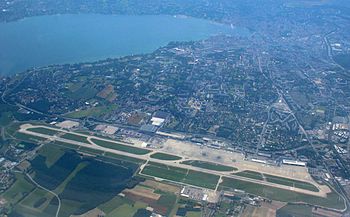| |||
| Auvergne-Rhône-Alpes region | |||
| Capital | Lyon | ||
|---|---|---|---|
| Residents | 7.994.459 (2018) | ||
| surface | 69,711 km² | ||
| no tourist info on Wikidata: | |||
| location | |||
 | |||
Auvergne-Rhône-Alpes is one of the 13 administrative regions in metropolitan France, which in 2016 came from the former regions Auvergne and Rhône-Alpes was formed. It is located in the south-east of France and borders on the to the east Switzerland (Cantons Vaud, Geneva) and Valais) and Italy (Regions Aosta Valley and Piedmont) and then to the south Provence-Alpes-Côte d'Azur and Occitania, in the west Nouvelle-Aquitaine, in the northwest Center-Val de Loire and in the north Bourgogne-Franche-Comté. For the purposes of this travel guide, it is divided into three travel regions.
Regions

places
- 1 Lyon
 - is the third largest city in France, capital of the Auvergne-Rhône-Alpes region, prefecture of the Rhône department. It is the second largest city in France and in some ways a “second capital”. Rich cultural heritage from antiquity to the present and a stronghold of French culinary art. The old town of Lyon is a UNESCO World Heritage Site.
- is the third largest city in France, capital of the Auvergne-Rhône-Alpes region, prefecture of the Rhône department. It is the second largest city in France and in some ways a “second capital”. Rich cultural heritage from antiquity to the present and a stronghold of French culinary art. The old town of Lyon is a UNESCO World Heritage Site.
Quai de Saône
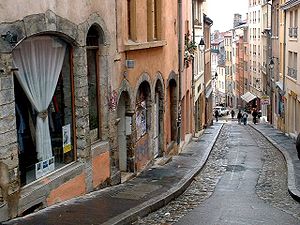
montée de la Grande Côte
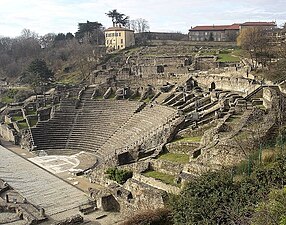
Amphitheater de Lyon

Place Carnot
Auvergne
- 2 Clermont-Ferrand
 - Prefecture (administrative seat) of the Puy-de-Dôme department, (unofficial) capital of Auvergne. City of art and history, cathedral, town hall, basilica, museums, parks, Place de Jaude, Amboise fountain, mansions of the old Montferrand, Chanturgue plateau.
- Prefecture (administrative seat) of the Puy-de-Dôme department, (unofficial) capital of Auvergne. City of art and history, cathedral, town hall, basilica, museums, parks, Place de Jaude, Amboise fountain, mansions of the old Montferrand, Chanturgue plateau.
- 3 Besse-et-Saint-Anastaise
 - Green holiday resort, beautiful village, church, Pavin lake and winter sports resort
- Green holiday resort, beautiful village, church, Pavin lake and winter sports resort
- 4 Montluçon
 - The medieval city that hugs the castle has given Montluçon the title City of Art and History. Its narrow streets, half-timbered houses and private villas bear witness to a rich past. Montluçon has kept its ducal castle, to which Ludwig II of Bourbon was very attached, intact. A dynamic and cultural city, Montluçon has just launched one of the most important music museums in France, the Museum of Popular Music (Mupop).
- The medieval city that hugs the castle has given Montluçon the title City of Art and History. Its narrow streets, half-timbered houses and private villas bear witness to a rich past. Montluçon has kept its ducal castle, to which Ludwig II of Bourbon was very attached, intact. A dynamic and cultural city, Montluçon has just launched one of the most important music museums in France, the Museum of Popular Music (Mupop).
- 5 Vichy
 - It's the Allier's tourist flagship. Its teeming architecture, its prestigious Art Nouveau opera house, its luxurious neighborhoods, its thermal baths, parks and gardens, its racecourse, its golf course and its fashion boutiques make it the queen of the baths in Auvergne. Vichy is also home to the Opera Museum, the Municipal Museum and the Museum of African and Asian Art, a true invitation to travel and discover other traditional and contemporary cultures.
- It's the Allier's tourist flagship. Its teeming architecture, its prestigious Art Nouveau opera house, its luxurious neighborhoods, its thermal baths, parks and gardens, its racecourse, its golf course and its fashion boutiques make it the queen of the baths in Auvergne. Vichy is also home to the Opera Museum, the Municipal Museum and the Museum of African and Asian Art, a true invitation to travel and discover other traditional and contemporary cultures.
Clermont-Ferrand
Besse-et-Saint-Anastaise
Montluçon
Vichy
- 6 Aurillac
 - Prefecture (administrative seat) of the department. Museum of the volcanoes, old town, art and archeology museum.
- Prefecture (administrative seat) of the department. Museum of the volcanoes, old town, art and archeology museum.
- 7 Saint-Flour
 - The old high fortress city lies on a solidified lava flow. Upper town with numerous Renaissance houses, St-Pierre Cathedral from 1398–1466 with a black Christ on the cross. Museum of Haute-Auvergne, Alfred Douët Museum of Art and History.
- The old high fortress city lies on a solidified lava flow. Upper town with numerous Renaissance houses, St-Pierre Cathedral from 1398–1466 with a black Christ on the cross. Museum of Haute-Auvergne, Alfred Douët Museum of Art and History.
- 8 Brioude
 - Old town with Saint-Julien Basilica (1060-1180), Atelier-Museum hôtel de la Dentelle, salmon aquarium and river house.
- Old town with Saint-Julien Basilica (1060-1180), Atelier-Museum hôtel de la Dentelle, salmon aquarium and river house.
- 9 Le Puy-en-Velay
 - Prefecture (administrative seat) of the Haute-Loire department. Worth seeing city in the middle of the volcanic landscape
- Prefecture (administrative seat) of the Haute-Loire department. Worth seeing city in the middle of the volcanic landscape
Aurillac

Saint-Flour
.jpg/300px-Chevet_de_Saint-Julien_de_Brioude_(tuiles_romaines).jpg)
Brioude

Le Puy-en-Velay
Rhône Valley
- 10 Valence
 - is the prefecture of the Drôme, it lies on the banks of the Rhône and has retained all the charm and authenticity that these historic cities of southern France reflect. Its colorful markets and gardens, the vitality of the districts and the inviting pedestrian zones herald Provence. Located a few kilometers south of the 45th parallel, the city is often referred to as the "Porte du Midi".
- is the prefecture of the Drôme, it lies on the banks of the Rhône and has retained all the charm and authenticity that these historic cities of southern France reflect. Its colorful markets and gardens, the vitality of the districts and the inviting pedestrian zones herald Provence. Located a few kilometers south of the 45th parallel, the city is often referred to as the "Porte du Midi".
- 11 Montélimar
 - has a picturesque, southern old town with good restaurants, the Château de Adhémar and an aviation museum are well worth seeing. Besides, it's City of Nougat with a nougat museum. From here the landscape begins to turn southern and anyone traveling from Lyon to the Mediterranean Sea will see the Mediterranean light for the first time here.
- has a picturesque, southern old town with good restaurants, the Château de Adhémar and an aviation museum are well worth seeing. Besides, it's City of Nougat with a nougat museum. From here the landscape begins to turn southern and anyone traveling from Lyon to the Mediterranean Sea will see the Mediterranean light for the first time here.
- 12 Bourg-en-Bresse
 - Prefecture (administrative center) of the department of Ain and the historical Bresse countryside.
- Prefecture (administrative center) of the department of Ain and the historical Bresse countryside.
- 13 Oyonnax
 -
-

Valence
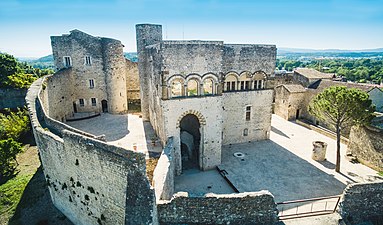
Montélimar
Bourg-en-Bresse

Oyonnax
- 14 Annonay
 -
-
- 15 Aubenas
 -
-
- 16 Saint-Etienne
 - is the prefecture (administrative seat) of the Loire department.
- is the prefecture (administrative seat) of the Loire department.
- 17 Montbrison
 -
-
Annonay

Aubenas

Saint-Etienne
Montbrison
- 18 Villefranche-sur-Saône
 - is the largest city in the wine-growing region Beaujolais
- is the largest city in the wine-growing region Beaujolais
- 19 Villeurbanne
 - is the most important suburb of Lyons, meanwhile grown into a big city itself, predominantly industrialized, interesting examples of classical-modern and postmodern architecture
- is the most important suburb of Lyons, meanwhile grown into a big city itself, predominantly industrialized, interesting examples of classical-modern and postmodern architecture

Villefranche-sur-Saône

Villeurbanne
French Alps
- 20 Chambery
 is the prefecture (administrative seat) of the Savoie department.
is the prefecture (administrative seat) of the Savoie department.
- 21 Albertville
 was the venue for the 1992 Winter Olympics
was the venue for the 1992 Winter Olympics
- 22 Grenoble
 - is prefecture (administrative seat) départements Isère and the Dauphiné.
- is prefecture (administrative seat) départements Isère and the Dauphiné.
Chambery
Albertville
Grenoble
- 23 Vienne
 -
-
- 24 Annecy
 - The department's capital lies on the shores of Lake Annecy, in the gulf between the Bornes and Bauges massifs, between Geneva and Chambéry. There are restaurants, hotels, a youth hostel, a museum palace, Palais de l'Île-Center d'interprétation de l'architecture et du patrimoine, churches, cathedral, basilica, gardens and parks, Pont des Amours, CITIA. Events from the Venetian Carnival to the Spanish Film Biennale, International Animated Film Festival, Noctibules, Lake Festival, Italian Film Festival and the Almabtrieb.
- The department's capital lies on the shores of Lake Annecy, in the gulf between the Bornes and Bauges massifs, between Geneva and Chambéry. There are restaurants, hotels, a youth hostel, a museum palace, Palais de l'Île-Center d'interprétation de l'architecture et du patrimoine, churches, cathedral, basilica, gardens and parks, Pont des Amours, CITIA. Events from the Venetian Carnival to the Spanish Film Biennale, International Animated Film Festival, Noctibules, Lake Festival, Italian Film Festival and the Almabtrieb.
- 25 Evian-les-Bains
 - Palais Lumière, Maison Gribaldi, town hall, theater and casino, funicular, church, Cachat refreshment bar, thermal park, Pré-Curieux water gardens, Evian water bottling plant in Amphion-les-Bains, spa and summer sports and leisure center, beach, port . Musical interim concerts, Evian Masters, summer theater, Le Fabuleux village.
- Palais Lumière, Maison Gribaldi, town hall, theater and casino, funicular, church, Cachat refreshment bar, thermal park, Pré-Curieux water gardens, Evian water bottling plant in Amphion-les-Bains, spa and summer sports and leisure center, beach, port . Musical interim concerts, Evian Masters, summer theater, Le Fabuleux village.

Vienne

Annecy
Evian-les-Bains
Other goals
- 1 Mont Blanc, with 4810 meters the highest mountain in the Alps and all of Europe (if you don't include the Caucasus), a destination only for experienced mountaineers.
- 2 Gorges de l'Ardèche - The approx. 30 km long gorge with the 60 meter high rock arch Pont d'Arc, the symbol of the department, is very worth seeing. The gorge can be viewed from the road at various viewpoints or from the water. The gorge is also accessible on foot for hikers.
background
The Auvergne-Rhône-Alpes has a great variety of landscapes due to its climatic and topographical differences.
The topography of the region consists of two high-lying areas, which are divided by the Rhone Valley, which runs in a north-south direction. The western mountains are part of the Massif Central. It is an area with high hills and plateaus, mostly made up of old, acidic, metamorphic rock. There are several recently extinct (geologically speaking) volcanoes in this mountain range. The Alps are to the east of the Rhône Valley. These high, young mountains are themselves very diverse and should be divided into at least two groups. A central part of the region is taken up by a north-south line of clearly defined mountain ranges: from north to south Bornes, Bauges, Chartreuse, Vercors and Baronie. These mountains consist mainly of limestone and develop into a karst landscape. Another, less pronounced valley separates this central area from the eastern part of the region, the actual Alps, in which some of the highest mountains in Europe, especially Mont Blanc, are located. These mountains are made of acidic rock like granite.
Auvergne-Rhône-Alpes was created in 2016 through the merger of the old regions of Auvergne and Rhône-Alpes as part of the national territorial reform. Unlike elsewhere in France, the local politicians could not agree on a completely new name for the larger region (other exciting proposals were "Auvergne-Alpes" and "Rhône-Alpes-Auvergne"), so the provisional alphabetical amalgamation of the old names was retained stayed.
language
French is the first language of almost all residents of the region. Locals will appreciate any effort made to speak French, even if their language skills are not very good.
As elsewhere in France, the Auvergne-Rhône-Alpes has its own regional languages, which are still gaining importance despite the almost complete lack of government support. The one from the Alpine region and the northern Rhone Valley Arpitan (or Franco Provençal) is a close relative of French, but the two languages are not to be confused with one another. In the Auvergne and the more southern parts of the region, as in the rest of southern France Occitan spoken. Here the local dialect of Occitan is called Auvergnat designated.
Visitors with limited or no knowledge of French should find their way around the major cities and ski resorts, all of which are popular with international tourists. In addition to English, locals and those working in tourism can also speak German and Italian.
When venturing off the beaten path to more rural areas, it can be more difficult to find people who speak a foreign language.
getting there
By plane
- The international
 Lyon Saint-Exupéry Airport
Lyon Saint-Exupéry Airport (IATA: LYS). offers numerous connections from the main cities of France as well as international connections. For example, there are daily flights from Frankfurt am Main, Munich, Stuttgart and Düsseldorf.
(IATA: LYS). offers numerous connections from the main cities of France as well as international connections. For example, there are daily flights from Frankfurt am Main, Munich, Stuttgart and Düsseldorf.
By train
Paris-Lyon was the first TGV (Train à Grande Vitesse, high-speed train) route, inaugurated in 1981, and it remains the flagship of the SNCF to this day. The journey time from the appropriately named Gare de Lyon in Paris is an impressive 2 hours, much faster than by car. Lyon is also only 1 hour 45 from Marseille and about 3 hours from Lille.
The western half of the region is not yet connected to the high-speed rail network, so the travel times of the intercités from Paris Gare de Bercy to Clermont-Ferrand and the rest of Auvergne are a more leisurely 3-4 hours. From further western parts of the region (e.g. Bordeaux, Loire Valley) there are few direct train connections from city to city, although there are daily intercités from Nantes, Tours and Bourges.
In the street
From Paris, Lyon can be reached in around 5 hours with good traffic on the A6 motorway, while Clermont-Ferrand can be reached in around 6 hours on the A10 and A71 motorways. The A89 brings traffic from the west - Bordeaux and the rest of Nouvelle-Aquitaine, while the A7 is the main motorway that brings traffic from the south, i.e. from Marseille and the rest of Provence-Alpes-Côte d'Azur.
From Italy there are two tunnels through the Alps, both of which lead from Turin. The A6 passes near Dijon, which is a junction for car routes from eastern France and finally from Germany.
mobility
By train
In addition to the TGV, which connects the main cities and ski areas in the eastern half of the region (i.e. the former Rhône-Alpes), is TER Auvergne-Rhône-Alpes the main provider of rail services. The route network is extensive, but service can be quite slow if you have a long distance to travel. But the train is very cheap. The few cities that do not have direct rail access are served by SNCF buses (Autocars), which are connected to the train network and use the same ticket and tariff system.
Since it is a mountain region, many of the train journeys are scenic. One of the highlights is the Mont Blanc Expresstackling the spectacular climb from Saint-Gervais-les-Bains to Chamonix before tunneling under the Alps and descending to the Swiss town of Martigny. While these and other wonderful journeys are integrated into the regular rail network, there are also lines that are purely for the tourist market, such as these AGRIVAP Discovery Trainsdriving a mix of steam and electric trains with panoramic and open cars through the Livradois-Forez Natural Regional Park between Lyon and Clermont-Ferrand.

Livradois-Forez panorama diesel railcar in Auvergne

Mont Blanc Express
Tourist Attractions
The region is richly endowed with fascinating Romanesque churcheswhich often date back to before AD 1000. If you visit, you can very likely hear beautiful music, definitely see lots of beautiful stained glass and history carved in stone. Many parish churches have painted their columns as they were when they were built.
activities
In summer the region is known for paragliding, hiking, climbing and canoeing. The areas around the Ardèche, Mont-Blanc, Vanoise and Vercors are particularly attractive.
Water hiking

- Water hiking on the Allier. It is the longest tributary of the Loire, crosses the Auvergne from south to north and is considered one of the most natural migratory rivers in France.
- The Gorges de l'Ardèche used to be an insider tip. Today it has become something of a "fairground" thanks to numerous boat rental companies and due to the intensive use of necessary regulations in midsummer. However, the grandiose gorge is still a pleasure, especially on working days outside of the holiday season.
Winter sports
In the winter months it is the heart of skiing in France as many of the largest and most developed ski resorts are located here.
- In the Annecy area there are slopes in close proximity to the city
- Chamonix hosted the first Winter Olympics in 1924 and has been winter sports capital ever since
- Le Grand Massif are low altitude ski areas that still get a lot of snow
- The Megève area is another low altitude resort in the foothills of the Mont Blanc massif
- Les Portes du Soleil is a transnational ski area that extends into the Swiss canton of Valais
- Savoy area is also known as Espace Killy after Jean-Claude Killy. This includes Les Trois Vallées, which claims to be the largest ski area in the world.
kitchen
The region is known for its agriculture and especially for its wine industry. Lyon is considered the culinary capital of France, if not all of Europe, and there are many well-known dishes from across the region.
Wine
Le Beaujolais nouveau est arrivé! - Every year on the third Thursday of November, the new Beaujolais wine arrives in bars and restaurants across France and in selected locations around the world. This wine comes from the historic province and wine-growing region of Beaujolais north of Lyon, which includes parts of the northern Rhône and parts of the southern Saône-et-Loire. It is a young wine that should be drunk as soon as possible as it does not age very well.
The regional wine landscape is dominated by the Rhone Valley. Wines of this appellation Côtes du Rhône generally use Grenache grapes for red and rosé wines and Grenache blanc for white wines. Premium varieties have a legally required higher Grenache content. The higher-quality variants are called Côtes du Rhône Villageswhile the very best as Crus who use the name of their home village and not the Rhone label. Rhône bottles are known for their longer than average necks, which make it easy to choose without even reading the label.
nightlife
security
This is a relatively low crime area, with the occasional theft of expensive ski equipment being a problem during the winter sports season.
Standard precautionary measures should be taken when going into the mountains, and avalanches are a recurring and well-publicized threat to safety in the Alps. All volcanoes in the region are dormant or extinct, but if you decide to wake up, you will be warned in good time.
climate
The different climates of the region are due to a mixture of four weather influences: Mediterranean in the south, alpine in the east, continental in the north and Atlantic in the west.
literature
Web links
https://www.auvergnerhonealpes.fr - Auvergne-Rhône-Alpes official website











.jpg/350px-Zone_urbaine_(VICHY,FR03).jpg)










.jpg/300px-Chevet_de_Saint-Julien_de_Brioude_(tuiles_romaines).jpg)







_(1).JPG/361px-Monastère_royal_de_Brou_(église)_(1).JPG)




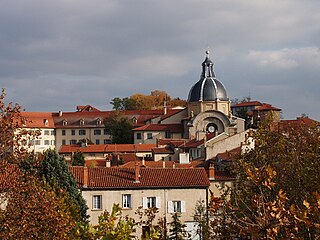









.JPG/320px-Albertville_depuis_le_belvédère_de_Conflans_(été_2018).JPG)


.JPG/300px-Albertville_depuis_le_belvédère_de_Conflans_(été_2018).JPG)










